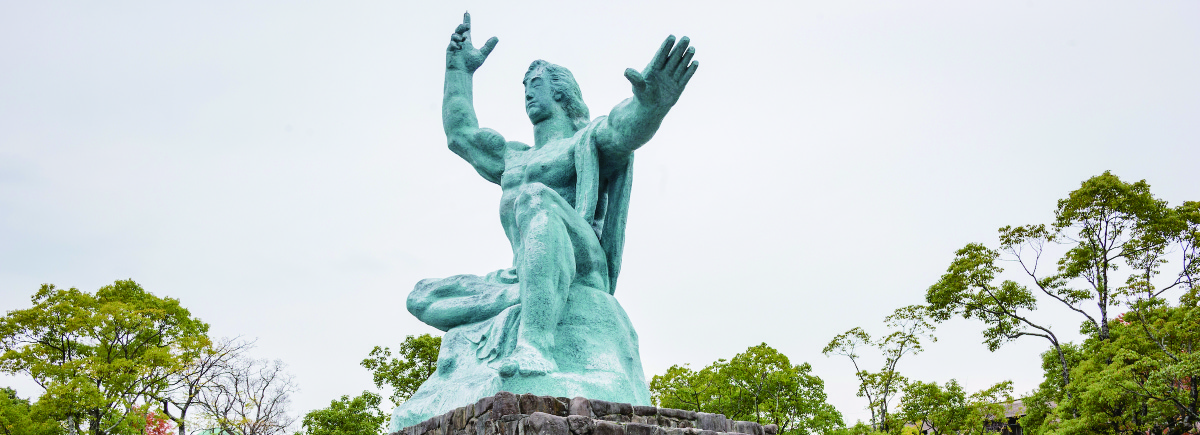Culture & History Trip
- AREA
- FUKUOKA SAGA NAGASAKI KUMAMOTO
- DAYS
- 2D1N
On the last day of November on a overcast misty morning I embarked on a 2-day tour of areas of Kyushu I have always wanted to visit, but never had the chance to. As I set off from Fukuoka City, I prayed for the overcast weather to lift so that the beautiful Japanese autumn colours all around could be appreciated to the full. Gradually it did so on the second day, a spectacular blue sky day that Japan seems to perfect so well. Being a photographer by profession I was keen to capture iconic shots.
My favourite spots included the overnight stay at Fukudaya Ryokan in Unzen. Soaking in an outdoor hot spring in the colder months of the year (especially autumn) is the ultimate Japanese experience and Kyushu is blessed with many amazing onsens.
Nagasaki city was also a highlight. The visit to the Atomic Bomb Memorial and museum left an indelible (and very educational) mark. I learnt so much history on this tour. The 26 Martyrs Museum was also a favourite. History came alive for me having previously read books on the subject.
Kyushu is also special to me as the first British person to arrive in Japan back in 1600 landed here (at Hirado) and I like to joke to Japanese people I meet that I’m the second Englishman to arrive!
There are so many contrasting things to do in Kyushu that you are spoilt for choice. Getting to all these places whether by train, bus, car or boat is always trouble free. You’ll get there on time. My tour was by car and apart from some rush hour traffic leaving Nagasaki city for Unzen I encountered few problems. The highway system is excellent and well maintained. I would say hiring a car to get around Kyushu is the best way to see it. You can go more off the beaten track than say travelling by train or bus.
Japan has a reputation – especially overseas – for highest quality food and seasonal ingredients with cuisine elevated to a ‘kaiseki’ art form. Kyushu has some of the best. At Kumamoto castle I sampled a beef bowl with the famed beef reared in the Aso volcanic caldera, the most verdant pastures in Japan. In Unzen ryokan I savoured local seafood delicacies and unique seasonal dishes. Not just the food but the quality of the water in Kyushu far surpasses Evian!.
In summary, as a resident of Fukuoka City this trip reminded me that many rich and varied experiences are to be found literally on my doorstep. Fukuoka is the first port of call for many overseas visitors and is a perfect starting point. My tour focused on the area west of Fukuoka – the prefectures of Saga, Nagasaki and Kumamoto and, of course, Fukuoka Prefecture itself. Kyushu National Museum in Dazaifu teaches how important this region has been to Japanese history.
Every overseas influence – be it from Asia (especially Korea and China) or Europe (Dutch, Portugese, British) entered Japan via Kyushu.
Even during the 200 years of isolation when Japan closed it’s borders Nagasaki remained open to the world.
Green tea came to Japan via Kyushu in the 12th century. Fukuoka is also the birthplace of udon, soba and ramen culture.
I’ve lived in Fukuoka for 4 years now and I’m still discovering. This tour opened my eyes to yet more discoveries.
I think it’s going to take me a few more years yet to take in the whole of Kyushu. I recommend if you are visiting Kyushu stay as long as you can. You won’t be disappointed. Kyushu tends to be last on the list to visit with overseas visitors preferring the more obvious destinations of Tokyo and Kyoto. They don’t know what they are missing!! – and I take it upon myself to be an ambassador for the wonders of Kyushu at every opportunity.
\ START /
DAY 1 Hakata Station
Yutoku Inari Shrine
After leaving Fukuoka City at 7:45am I arrived exactly on schedule at Yutoku Inari Shrine. I like visiting shrines when there is no other visitor around as it puts me in a more contemplative mood as befitting such an experience. When I arrived the staff in immaculate traditional wear were still doing ‘souji’, the daily morning ritual of tidying the shrine grounds. I had hoped for a sunny day to enjoy the ‘koyo’ autumn colours more vividly but the sombre diffuse light of the misty morning also made for an interesting atmosphere to enjoy the shrine. I’ve visited Fushimi Inari in Kyoto (a sister shrine) so it was a nice deja-vu experience walking once more down a tunnel of bright vermillion ‘torii’ gates that wound their way up the hill. Que *movie moment* – Memoirs of a Geisha, if you’ve seen the movie. Visiting this shrine during autumn is recommended as the reds of nature perfectly match the reds of the shrine buildings and torii gates. To check on my luck and future I paid a 200yen donation for an ‘omikuji’ (fortune). It included a lucky bell charm ‘to bring happiness and make my dreams come true.’ It seemed to work immediately what with the ninja I was about to meet at the next stop ...
The plan was to dress in a kimono and have my photo taken but I arrived too early before 10am, the official opening time. I had an excellent Yutoku Inari Shrine visit all the same and next stop… Ninja! I was in the mood for some action...
Yutokuinari Shrine
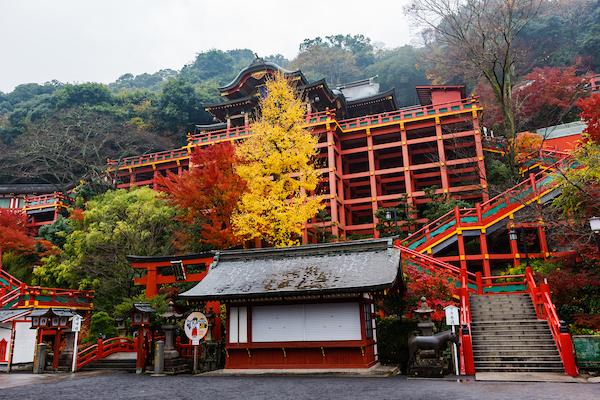
Ninja Village (Hizenyumekaido)
The ninja ‘mura’ (village) was a fun experience and the guide who showed me around wasn’t what I was quite expecting. The ninja was a young female named Orin (which means ‘bell’ so the lucky bell charm from Yutoku shrine clearly was a prophecy.
She was professionally trained in ninja techniques. I practiced throwing “shurinken” (metal star weapons) but missed every time, whereas Orin managed to bullseye effortlessly.
The village transported me back in time with its various re-constructed old buildings of undetermined age. I have a soft spot for “mukashi” (olden times) so it was great to check out the ‘minka’ and ‘kura’ period structures with “irori” (fireplaces) and “doma” (earthen floor kitchens.) One can roam at will once entering the village so it’s a relaxing atmosphere.
The Yamada Zenjido museum with interesting ukiyo-e wood block prints with a contemporary Japanese twist is worth a look.
Hizen Yume Kaido (Hizen Dream Road)
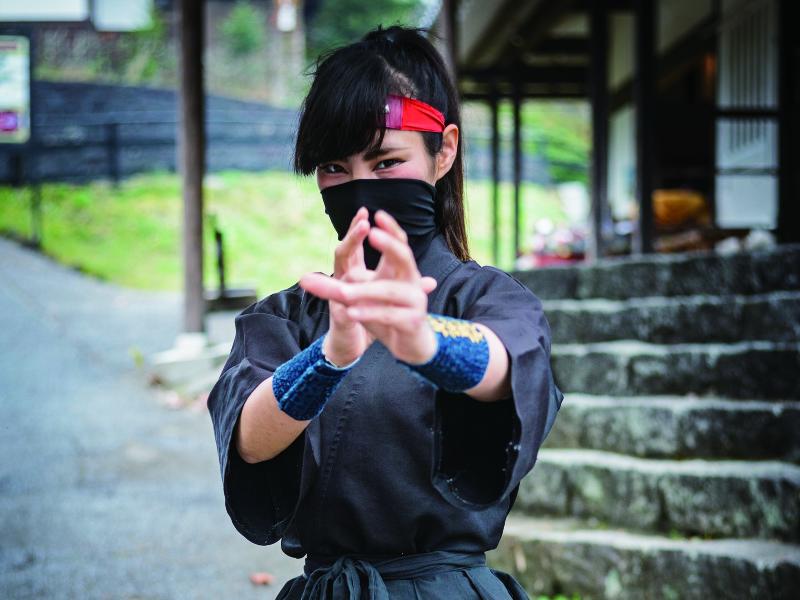
Ureshino Onsen Foot bath
This footbath was a welcome stop for my aching limbs. And as with all onsens, if you are a chatty person like me, it is a place to meet people. I met a mother and daughter visiting Ureshino from Fukuoka so I got to practice my nihongo (Japanese language) on them and talk about ‘neko’ (cats) as while we were all enjoying the onsen a stray cat came to check us out. “Ureshi” means happy in Japanese and for sure this small town called Ureshino is a happy place. It’s also famous for its tea –green tea and kocha black tea. The water was just the right temperature to pop your feet in and I liked the little tatami mat seats to sit on instead of bare stone, a little softer on your behind. Twenty minutes is the recommended time frame to enjoy this foot bath. I felt great afterwards and my knee pain lessened somewhat.
Ureshino Onsen
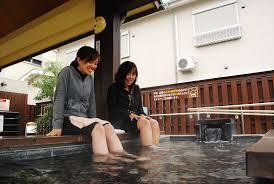
Yu-Tofu
After a slight detour to check out an 800 year old tree (Kyushu has many very, very old trees dotted around the prefectures especially Saga), I headed for a hotpot lunch cooked in onsen water. I appreciated the merits of ‘shojin ryori’ zen bhuddist vegetarian cuisine. I arrived just before midday and all the tables in the restaurant were almost all taken so make sure to make a reservation. For such a high quality food experience the menu is surprising affordable. I ordered the set menu comprising various dips and sauces that allow for eating the simmered tofu in different ways. There was ponzu, shoyu (sweet soy sauce) and gomadare (sesame sauce) plus garnishes of grated ginger. First off the cast iron ‘tetsu nabe’ pan full of onsen water is brought to a slow simmer and the fresh tofu blocks added. After a few minutes the onsen water becomes cloudy white and the tofu breaks down and glistens after which you can start to eat it by adding a ladleful to the various bowls. Vegetables (carrots and chinese cabbage) are added to the stew. Onsen water has a detoxification effect so after this meal my skin was glowing like a baby.
Onsen Yudofu (Tofu boiled with hot spring water)
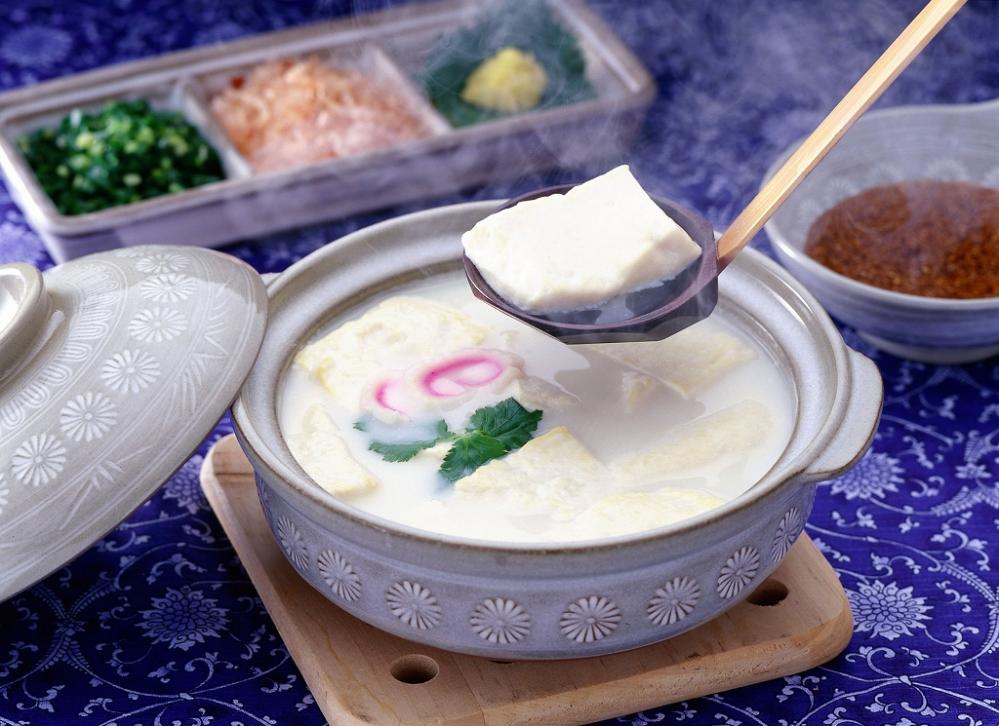
Peace Park・Atomic Bomb Museum
After the fun and enjoyment of Ureshino I headed to Nagasaki for a contrasting sobering several hour experience. I learned about the atomic bomb dropped on Nagasaki over 70 years ago on 9 August at 11:02am 1945. 175,743 people lost their lives. Heiwakoen ‘Peace Park’ contains the exact hypocentre of the bomb. The remains of the Christian cathedral to the right of the hypocentre monument add a scary ‘connection’ with the past. Nagasaki was a thriving multicultural city for 347 years until that fateful day. Feeling a little embarrassed, I tried to hide my eyes welling up in emotion. Be prepared. Seeing what happened to Nagasaki was a stark reminder of what should never happen ever again. The atomic bomb museum includes original salvaged artifacts and remains, a replica of ‘Fat Boy’ the actual bomb itself and a scale relief model of Nagasaki city with a vivid LED visualization of the actual bomb blast. Do visit for yourself just as so many Japanese school children in big groups were doing the day of my visit, all of them taking copious notes.
Perhaps the most lasting poignant image of what I saw that afternoon was the clock face frozen at 11:02am the time of the blast and a quote on the wall... “Nagasaki must be the last place exposed to a nuclear bomb.”
Peace Park
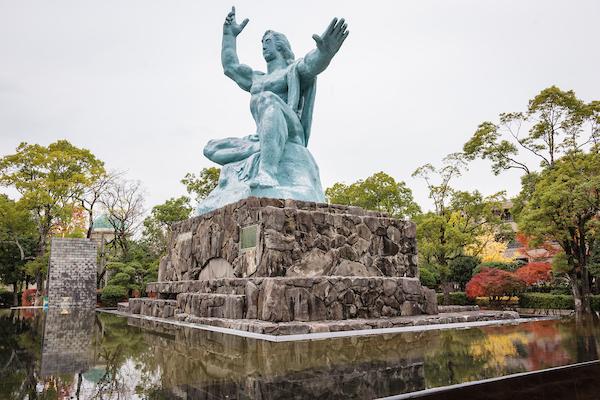
Glover Garden
After the A-bomb museum I headed to the 26 Martyrs Museum for a double dose of tragedy in just one afternoon.
I had a one-on-one informative tour of the museum by the manager.
One of my original introductions to Kyushu and its historical links with overseas cultures is the book ‘Silence’ (Chinmoku) a novel based on historical fact by Shūsaku Endō about the persecution of the Christian missionaries in the 16th century. It was made into a movie by Martin Scorsese in 2016. There are things made for the movie on show in the museum. Wasn’t expecting to find a little bit of Hollywood in a small museum in Nagasaki! To see first hand the original letter by one of the 26 martyrs written in 1621 and sent to Rome to inform of the persecution is incredible. It’s also written on washi paper which clearly ages well. There are books and paraphernalia on display. A porcelain figurine with its glaze melted and one foot broken off, a result of the atomic bomb blast, acts as a double metaphor for tragedy. Man’s inhumanity to man twice! If caught with one of these figurines at the time of the banishment of Christianity, you would be arrested and killed if you didn’t repent.
With all the museums and history Nagasaki offers this city offers a very educational (and sometimes shocking) experience for the foreign visitor.
It is an important part of the history of modern Japan. This is clearly evident by the number of school children visiting the museums.
Glover Garden
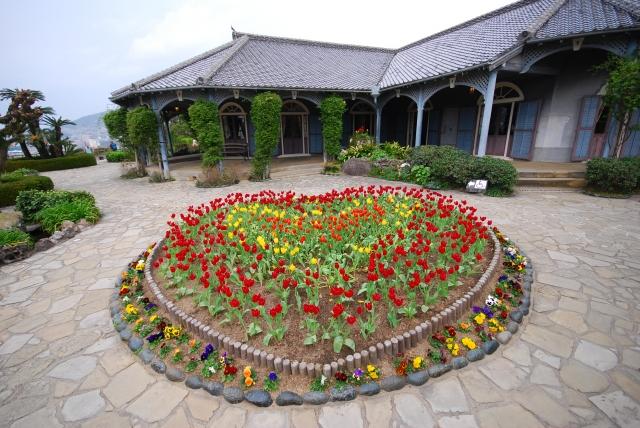
Unzen Onsen
The final section of the drive up to the ryokan was on narrow hairpin bends surrounded by deep forests heightening the feeling of remoteness. The location is an excellent ‘escape’ from the city. I enjoy arriving at places under nightfall and waking up at dawn to a whole new (beautiful) world and Unzen was no exception, especially in autumn with the cold weather making the onsen mists ever more steamy. I arrived after dark at around 7pm.
The very friendly staff showed me to my room and at 8pm dinner was served. I ate in the hotel’s “nabe” (hot pot) restaurant in a private dining room. My multi course “kaiseki” style meal consisted of sashimi served in a dramatic way with dry ice, the area’s local delicacy “Amakusa awabi” (abalone), and Nagasaki’s famous “wagyu” (Japanese beef) eaten sukiyaki style. The awabi, fried fresh in a pot with butter, was a little daunting as the abalone was still alive. Strangely, a Swiss cheese fondue was featured in the meal contrasting with the other 100% Japanese dishes.
Following dinner at 9:30pm I basked in the outdoor onsen. They rotate the onsens (male / female bathing switch) so you get to try a different one evening and morning. The outside temperature was around 6-8c. While I was submerged in the warm waters, the wind carried the onsen steam out into the forest. It was a clear night and the stars were shining bright under a crescent moon. I slept very well and if you leave the window slightly ajar you can drift off to the sound of the flowing stream under the window.
So as to not waste any moment, I woke before dawn at 6am to make full use of the therapeutic onsen waters. Floating in the outdoor onsen pool under a tsubaki bush as dawn was breaking was the perfect start to the day, and another uniquely Japanese experience.
After a very deep sleep and the invigorating early morning onsen I had “asa gohan” (breakfast,) a feast to match the scale of dinner the night before. Oyudofu was served (just like in Ureshino) using the local onsen waters. “Aji” (horse mackeral) grilled on a table top “konro” (grill). White rice, pickles and miso shiro (soup.) Omelette. Various rice toppings including “mentai” (spicy cod roe) a popular Kyushu condiment, excellent on hot rice or folded into an omelette. Don’t expect to leave this hotel hungry.
Unzen Hell

\ START /
DAY 2 Unzen Hell
Shimabara Castle
Under perfect blue skies with autumn in full colour, I enjoyed exploring the grounds of Shimabara Castle. It’s coastal location adds a different feeling compared to more inland castles such as Kumamoto castle which I would visit later in the day. Today would be two castles in one day. Shimabara Castle has spectacularly steep and high walls making it impenetrable in its day.
While walking to the castle after parking the car I discovered ‘Koi no mizube michi’ a traditional ‘carp stream’ that flows along a very old street full of traditional Japanese residences, possibly a part of the original castle town. The water was so clean. Another unexpected discovery aside to our planned itinerary!
Shimabara Castle
HOURS OF OPERATION : 9am ~ 5:30pm
FEES : Adult 540 yen, Students 270 yen
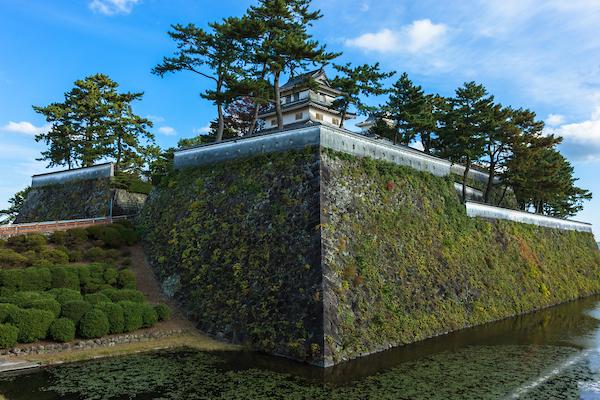
Kumamoto Castle
The castle itself is still under renovation due to the earthquake but don’t be deterred from visiting as there is still much to see and do around it.
There is a new castle annex full of shops and attractions where I ordered a famous regional dish called Jyosaien, a bowl of natural grass fed beef from the pastures of Aso, Kumamoto on rice. The beef melts in your mouth. Outside, the ginkgo trees were at their full autumn splendor with bright yellow leaves cascading down and forming a yellow carpet at my feet. Seeing the extensive damage to the castle was a little sad, but Japan’s ‘ganbaru’ attitude to everything (never give up; try one’s best) the renovations appeared to be going very well and I look forward to returning to see the castle when it opens to the public once more.
Kumamoto Castle
FEES : High school students and older: 500 yen (400 yen). Elementary/Junior high school: 200 yen (160 yen). *Numbers in brackets are group prices.
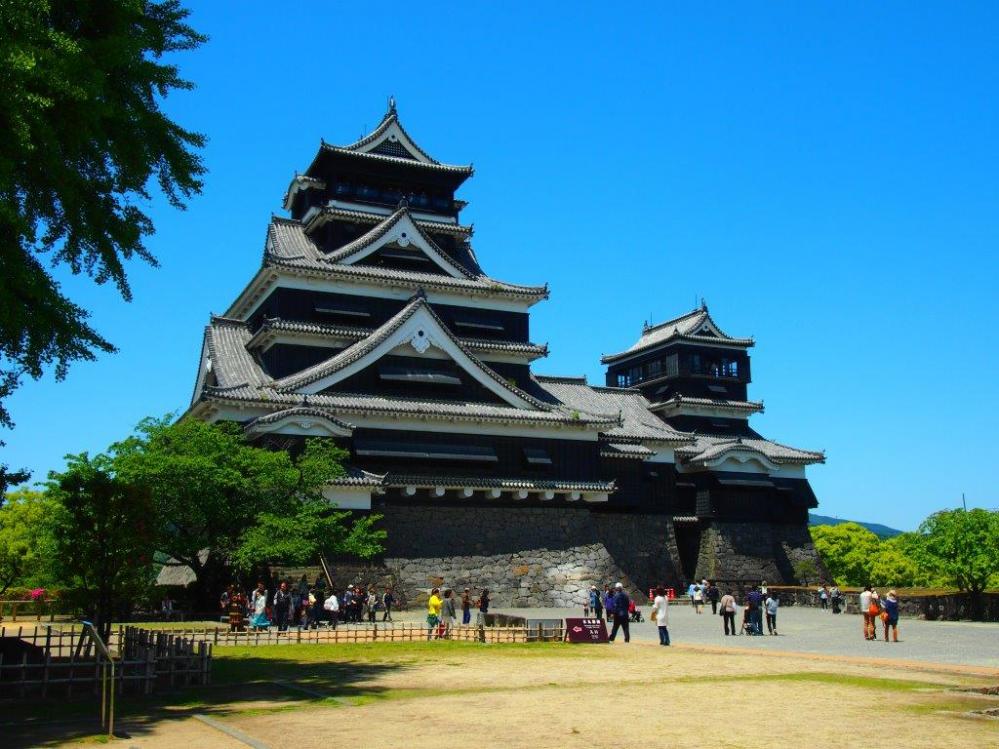
Suizenji Park
Suizenji Park was a pleasant surprise as it’s easy to overdose on Japanese style gardens in Japan – there are so many! Lord Tadatoshi Hosokawa of Kumamoto started work on this garden in 1636 as a tea retreat. It includes a miniature Mt. Fuji and the 53 post stations of the Tokaido, the important road, which connected Edo with Kyoto during the Edo Period. Suizenji Park has been designated a historic site of scenic beauty by the Japanese government. The lakes in the park are packed with fish – the water is pure natural spring water for which Kumamoto is renowned. In fact, the whole of Kumamoto city the tap water in every household is mineral water!
It is picture perfect, more so than other parks I’ve visited. At the entrance to the park you can savour Kumamoto delicacies such as a sweet potato based snack called ‘Ikinari Dango’ served with green tea, a perfect compliment. I loved the natural purple colour and mild sweetness. After the snack it was straight back to the car and the expressway direct to Dazaifu, the ancient governing capital of Kyushu.
Suizen-Ji Joju-En
HOURS OF OPERATION : Mar. - Nov., 7:30 A.M. - 6:30 P.M. Dec. - Feb., 8:30 A.M. - 5:00 P.M.
FEES : High school students and older: 400 yen (360 yen). Elementary/Junior high school: 200 yen (180 yen). *Numbers in brackets are group prices.
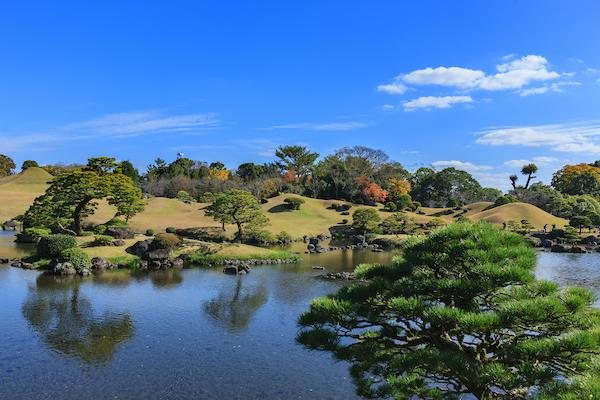
Dazaifu Tenmangu
My visit to DazaifuTenmangu was very swift as light was failing. The ancient Shinto shrine that visitors can see today dates from 1591. It is dedicated to the spirit of Michizane Sugawara who lived over a thousand years ago and is deified as the god of literature and calligraphy. Dazaifu Tenmangu is famous for its 6000 plum trees of over 150 varieties and is always packed with tourists. There is ample car parking but it’s easier to take the direct train from Yakuin station in Fukuoka to beat the slow moving traffic, especially at rush hour. As with Kumamoto, Dazaifu has its famous sweet treats. Invented in Dazaifu, Umegae Mochi is a mochi rice cake filled with sweet red bean paste. “Oishii!” (Delicious.) Careful not to eat one straight away as you can burn your tongue on the piping hot red bean paste. Umegae mochi is shaped like an ume (plum) blossom, the emblem for Dazaifu Tenmangu (shrine).
Dazaifu Tenmangu Shrine
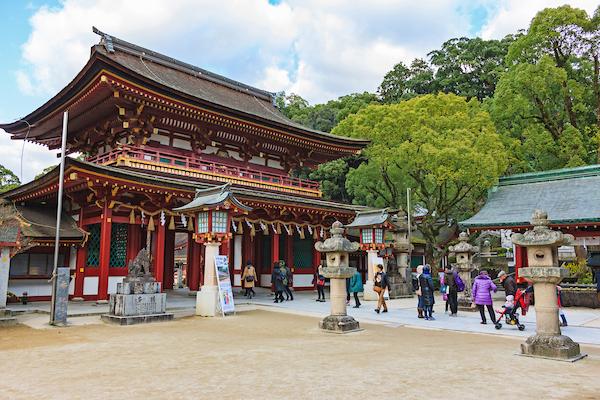
Kyushu National Museum
Now this museum is special! I’ve visited Dazaifu Tenmangu many times to view autumn ‘koyo’ (the changing colours) and the famed plum and cherry blossoms in spring but I’d never actually entered the museum, only seen the distinct wave like architectural from afar. I was privileged to be given a tour of the museum by the public relations director. It was yet another eye opening learning experience, viewing the ancient artifacts dating as far back as the 4th century (and earlier). It brought home how rich the history and culture of Kyushu is. I would thoroughly recommend a visit. They also feature an interactive display about the exchange of goods and produce between China and Japan. A great ‘hands-on’ experience getting to touch old coins, silk fibres and smelling produce from the spice trade. I also got to dress up in a Yamakasa outfit. Yamakasa is an annual festival held in Hakata that has taken place pretty much every year (in July) since the 12th century.
Kyushu National Museum
HOURS OF OPERATION : Tuesday-Sunday, 9:30am-5pm (entry by 4:30pm)
FEES : Adults 430 Yen; High School and University Students 130 Yen
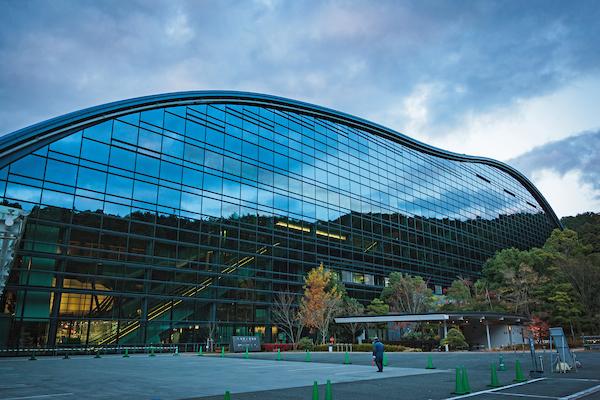
Yatai Food stall
My ‘grand tour’ came to a close with a meal at a ‘yatai,”, a food stall that pop-ups every evening at around 6pm on the pavements of Fukuoka. This particular evening there was a distinct chill in the air so it was great to huddle in the warmth of a cozy yatai to the smell of Japanese ‘comfort food’ – simmering oden, yakitori spitting on the grill and yakisoba steaming away on the hotplate. The yatai has operated for around 40 years. I sampled a few ‘osusume’ (recommended) dishes. I particularly liked simmered “daikon” (radish) with a dab of karashi (mustard) to warm me up from the cold. Compliment this with a nama biru (draft beer) and you are ready for the next best thing about yatai – meeting new friends and chatting with the local regulars who frequent the stalls. The yatai are very compact structures and thus conducive to socializing. It’s a great way to get to know Fukuoka. Yatai are also a great place to meet fellow travellers and exchange experiences, thus a fitting end to my tour of Kyushu and all the new things I learnt over the past 2 days.
Yatai (Food Stalls)
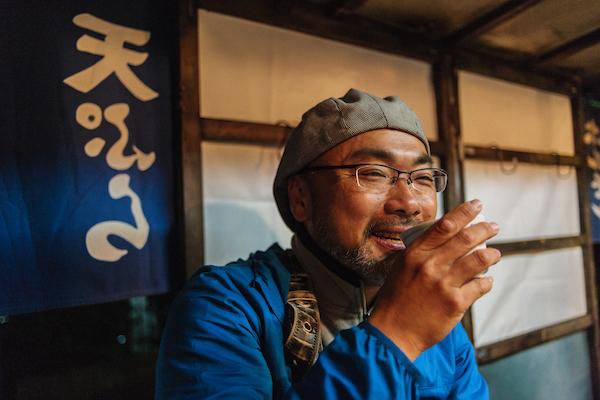
\ GOAL /
DAY 2 Fukuoka
